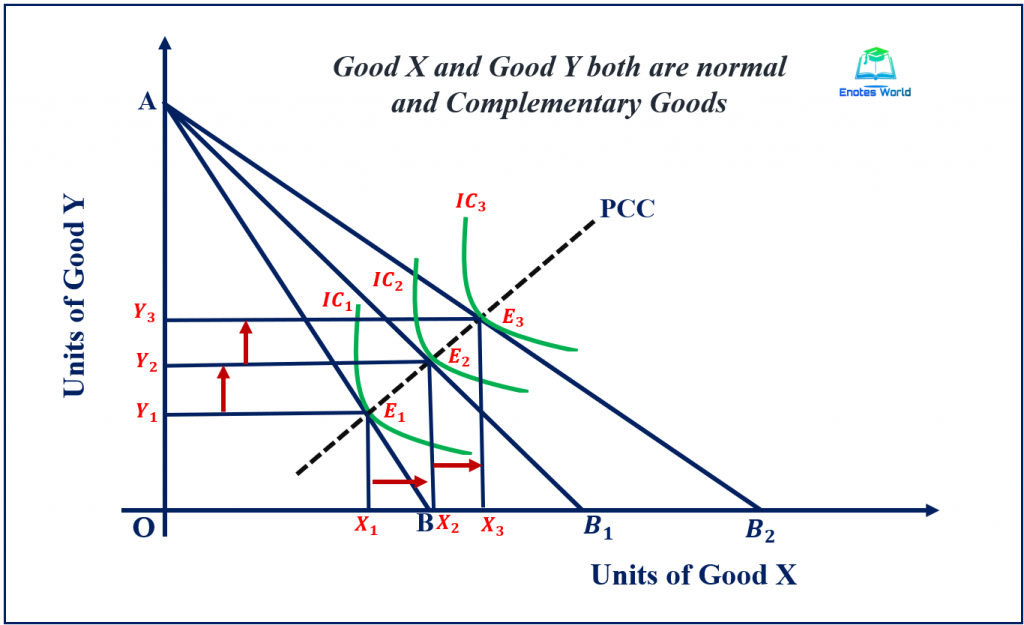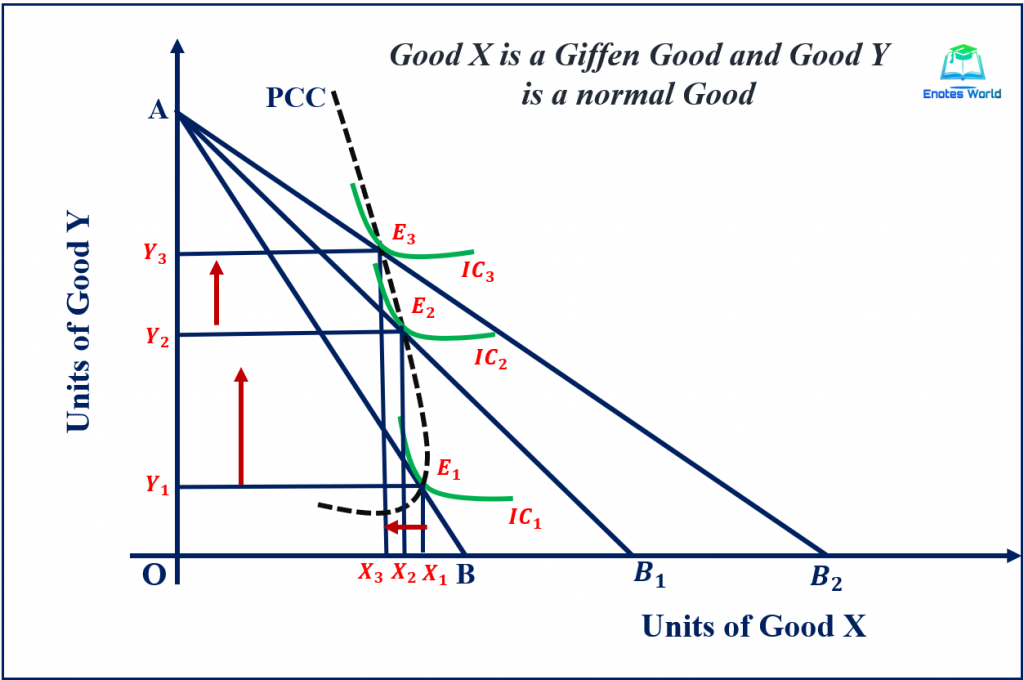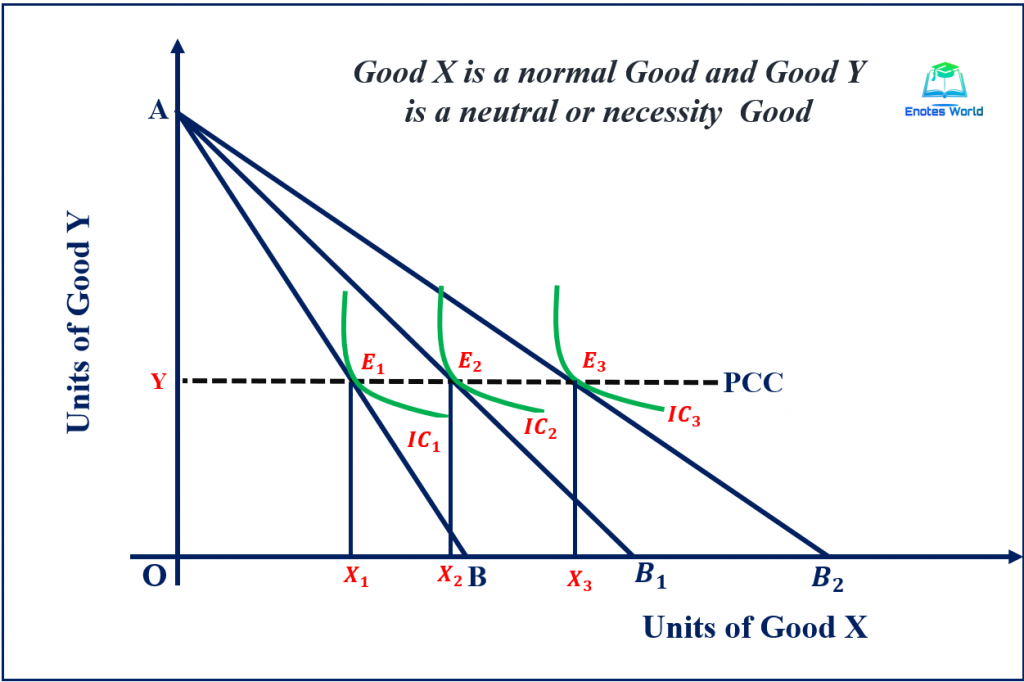Consumer’s equilibrium is derived under ordinal utility analysis with the assumption of constant money income and prices of the goods. But in reality, consumer preference, money income, and prices are important factors affecting consumers’ objective of utility optimization. A consumer’s preference for goods and services directly changes with the change in income of the consumer and the prices of the goods. Therefore, here we will discuss the meaning of the price effect, the effect of change in price on consumer preference, and the derivation of the price consumption curve (price effect and price consumption curve-PPC).
Contents
Meaning of Price Effect (PE)
The price effect deals with the change in quantity demanded of a commodity as a result of the change in its price, assuming other things remain the same. It means, assuming the income of the consumer, prices of other commodities, and taste and preference remain the same if we see the effect of change in the change in the quantity of commodity due to the change in its price, it is a price effect. Therefore, the price effect changes in the consumption of a commodity due to the change in the price of the commodity.
When the price of the commodity changes, the buyers can buy more or fewer units of the commodity. They can purchase more quantity when the price is lower and they can purchase less quantity when the price is higher. Thus, the price effect shows the total effect on the consumer’s demand for a commodity due to a change in the price of the same commodity, with other things remaining the same.
Meaning of Price Consumption Curve (PCC)
PCC is the locus of various equilibrium points obtained when the price of any one commodity changes. With a change in the price of a commodity, there is a change in the consumer’s equilibrium point as well. if we join consumers’ equilibrium points established at different prices, we get the curve that is known as the price consumption curve. The shape of PCC is based on the relationship between two goods that we have considered in our analysis.
Price Effect and Derivation of PCC in Different Goods
Here we will see the effect on the consumption of different types of goods due to the change in their prices.
Price Effect (PE) in the Case of Normal Goods
Normal goods are those goods whose quantity demand is inversely related to their prices. It means if the price and quantity demand are inversely related to each other, the given good is known as a normal good. Normal goods are also categorized into substitute ones and complementary ones.
Substitutable goods and PCC
Those goods are known as substitute goods that we can use in place of each other. In this type of relation, if the price of one good declines, the demand for other goods will also decline and vice-versa. It means the change in the price of one commodity and the change in demand for another related substitutable commodity is moving in a positive direction. In the case of substitutable goods, the PCC is downward sloping, showing a positive relationship between the change in the price of one commodity and the change in demand for its related commodity. The following figure shows the price effect in the case of substitute goods and the downward-sloping price consumption curve.

In the above figure, good X is measured along with X-axis, and good Y is measured along with Y-axis. We have also assumed that goods X and Y are normally substitutable goods to each other. AB is the initial budget line. Initially, the consumer is in equilibrium at point E1 on IC1. Suppose there is a decrease in the price of Good X, assuming the price of Y and money income remains the same. With a decrease in the price of good X, the real income of the consumer increases (it is because with the same money income consumer can now buy more quantity of good X). This is represented by the outward-rotated budget line AB1.
In a new budget line AB1, the consumer is in equilibrium at point E2 on the higher indifference curve IC2. At the new equilibrium point E2, the buyer purchases more units of good X and reduces the demand for good Y because these goods are substitute goods. Similarly, again when the price decreases, the budget line AB1 will swing rightward to AB2, and the consumer will be at equilibrium at point E3 on the upper indifference curve IC3. At this new equilibrium point, the consumer has consumed more units of good X and reduced the consumption of good Y.
If we join the equilibrium points E1, E2, and E3, we will obtain a downward-sloping curve which is known as the price consumption curve. Thus, PCC is the locus of several consumer equilibrium points resulting from the variation in the price of the commodity.
Complementary goods and PCC
When the goods are consumed or need to be consumed together to fulfill a specific want then such goods are known as complementary goods. In the case of the complementary relationship between two goods, a good cannot be consumed in isolation form. If there is a change in the price of one good (generally major good in a complementary relation, like the price of a car in car and petrol) then the demand for its complementary goods will change in the opposite direction.
The price consumption curve in the case of complementary goods is upward sloping, indicating the inverse relationship between the change in the price of one good and the resulting change in quantity demand of its complementary good. The following figure shows the price effect in the case of complementary goods and the upward-sloping price consumption curve.

In the above figure, the X-axis shows units of good X and the Y-axis shows the units of good Y. AB is the initial budget line and with AB budget line consumer is in the equilibrium at point E1 on IC1. At the initial equilibrium point, X1 units of good X and Y1 units of good Y are consumed.
Suppose there is a decrease in the price of good X. As a result of a decrease in the price of good X, the budget line swings towards the right to AB1. In this situation, the consumer is in equilibrium at point E2 on the upper indifference curve IC2. At point E2, the consumer consumes more units of both goods X and Y. Similarly, if the price of good X falls again, the consumer attains equilibrium at point E3 on a higher indifference curve IC3 with higher units of both of the goods.
Here the consumer is increasing the demand for both goods at every new equilibrium point than before. It is because of the complementary relationship between good X and Y. So, if we join all the equilibrium points, we will get an upward-sloping price consumption curve (PPC). Thus, the PPC slopes upward in the case of normal complementary goods.
Price Effect (PE) in the case of Giffen Good
When the demand for a good decreases with a decrease in price and increases with an increase in price then such a good is known as a Giffen good. It means, in the case of Giffen goods, price, and demand are related to each other positively. Here we will show the derivation of PCC taking the combination between a Giffen good and a normal good. Suppose good X is a Giffen good and good Y is a normal good. Here we want to see the effect of change in the price of Giffen goods on the consumer’s equilibrium. The PCC so derived will be backward bending as shown in the following figure.

In the above figure, the X-axis shows units of good X (Giffen good), and the Y-axis shows the units of good Y (normal good). AB is the initial budget line and with the AB budget line consumer is in the equilibrium at point E1 on IC1. At the initial equilibrium point, X1 units of good X and Y1 units of good Y are consumed.
Suppose there is a decrease in the price of Giffen good X. As a result of a decrease in the price of good X, the budget line swings towards the right to AB1. In this situation, the consumer is in equilibrium at point E2 on the upper indifference curve IC2. At point E2, the consumer consumes more units of both good Y and fewer units of good X (Y2 and X2 units respectively). Similarly, if the price of good X falls again, the consumer attains equilibrium at point E3 on a higher indifference curve IC3 with higher units of normal good X and lower units of Giffen good Y.
Here the consumer is increasing the demand for good Y only at every new equilibrium point than before. And the demand for good X has decreased at every new equilibrium point as it is a Giffen good. So, if we join all the equilibrium points, we will get a backward-bending price consumption curve (PPC). Thus, the PPC is backward bending in the case of a combination of normal and Giffen good.
Price Effect (PE) in the case of Necessities or Neutral Goods
These are the types of normal goods. Those goods are essential or necessary for neutral goods whose quantity demand will not depend on the price. It means the rise and fall in the price do not affect the demand for necessities. The price consumption curve in the case of neutral goods is parallel to X-axis. Here, we take the combination of normal good (Good X) and an essential or neutral good (Good Y). We are interested to see the effect of change in the price of good X on the consumer’s equilibrium. The price consumption curve so derived is horizontal. The following figure shows the horizontal PCC of the price effect in the case of necessary goods.

In the above figure, the X-axis shows units of good X (normal good) and the Y-axis shows the units of good Y (essential good). AB is the initial budget line and with the AB budget line consumer is in the equilibrium at point E1 on IC1. At the initial equilibrium point, X1 units of good X and Y units of good Y are consumed.
Suppose there is a decrease in the price of normal good X. As a result of a decrease in the price of good X, the budget line swings towards the right to AB1. In this situation, the consumer is in equilibrium at point E2 on the upper indifference curve IC2. At point E2, the consumer consumes more units of good X only and no change in consumption of good Y. Similarly, if the price of good X falls again, the consumer reaches equilibrium at point E3 on a higher indifference curve IC3 with higher units of normal good X and no change in demand of good Y.
Here the consumer is increasing the demand for good X only at every new equilibrium point than before and the demand for good Y remains the same. So, if we join all the equilibrium points, we will get a horizontal price consumption curve (PPC). Thus, the PPC is parallel or horizontal in the case of a combination of essential and normal goods.
Conclusion
The price effect is the change in quantity demand due to a change in the price of the commodity. Assuming the income of the consumer and the price of other goods in combination remains the same when there is a change in the price of a commodity it has a direct effect on its quantity demand. Therefore, the effect of change in price on the equilibrium of the consumer is studied under the price effect. The share of the price consumption curve helps to identify the nature of goods.
However, the shape of the PPC of any good may not match our discussion in practical life. Thus, the discussion on the price effect and price consumption curve has provided a detailed picture of the behavior of consumers and their response to the change in prices of the commodities. Theoretically, we can understand the behavior of consumers with the help of price effects and the derivation of the price consumption curve.
Summary Table
| Combination of Goods | Shape of PCC | Price-Demand Relation |
| Normal and substitutable goods | Downward Sloping PCC | Change in the price of one good and demand for substitutable good has a positive relation |
| Normal and complementary goods | Upward Sloping PCC | Change in the price of one good and demand for complementary good has a negative relation |
| Normal and a Giffen good | Backward Bending PCC | Change in price and demand for Giffen good has a positive relation |
| Normal and a necessity good | Horizontal PCC | There is zero relation between change in price and demand for necessary goods. |
References and Suggesting Readings
Acharya, K.R. (2018). Microeconomics. Kathmandu: Asmita Books Publishers & Distributors (P) LTD.
Ahuja, H.L. (2017). Advance Economic Theory. New Delhi: S. Chand & Company.
Dhakal, R. (2019). Microeconomics for Business. Kathmandu: Samjahan Publication Pvt. Ltd.
Dwivedi, D. N. (2018). Microeconomics Theory and Application. New Delhi: Vikas Publishing House PVT LTD
Kanel, N.R. and et. al. (2019). Microeconomics for Business. Kathmandu: Buddha Publications.
Shrestha, P.P. and et. al. (2019). Microeconomics for Business. Kathmandu: Advance Saraswati Prakashan.